Human Eye
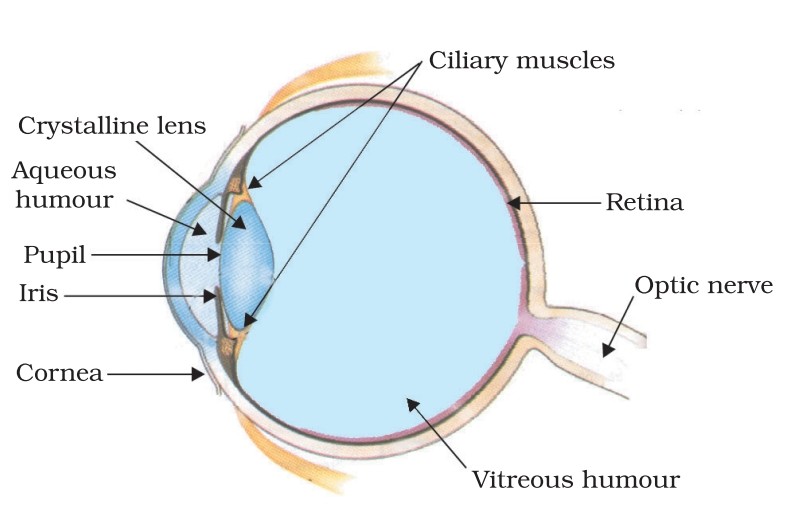
- Parts of human eye: cornea, iris, pupil, ciliary muscle, eye lens(crystalline lens), retina.
- Fluid in eye: Aqueous humour- between cornea and eye lens. Vitreous humour-beeween eye lens and retina.
- Cornea: Outermost thin membrane of eye. Light gets refracted when passes through cornea.
- Iris: Iris is a dark muscular diaphragm that controls the size of the pupil. Colour of the eye is due to iris.
- Pupil: A small opening at the middle of iris. Pupil regulate and control the amount of light entering the eye.
- Crystalline Lens: A convex lens(converging lens) is present in the eye which forms real and inverted image on the retina.
- Ciliary Muscles: Crystalline lens is attached with a pair of ciliary muscles. It can contract and relaxes to adjust the focal length of Crystalline Lens.
- Retina:The retina is a delicate membrane having enormous number of light-sensitive cells. The light-sensitive cells get activated upon illumination and generate electrical signals. These signals are sent to the brain via the optic nerves. The brain interprets these signals, and finally, processes the information so that we perceive objects as they are. Rods and cones are specialized cells in the retina that detect light and help us to see. Rods are used for night vision, while cones are used for daytime vision. Rods do not distinguish colour but cones detect colour.
Q. What do mean by least distance of distinct vision?
Ans. The least distance of distinct vision is the closest distance at which a person can see an object clearly, without straining their eyes. For a normal human eye, this distance is about 25 cm.
Q. What do you mean by near point and far point?
Ans. The minimum distance for clear vision is called near point. For a normal eye near point is 25cm. The maximum distance for clear vision is called far point. For normal eye far point is infinity.
Q. Define Power of accommodation. How one can see nearby as well as far off objects clearly?
Ans. The ability of the eye lens to adjust its focal length is called power of accommodation. This is done through ciliary muscles. When a person needs to see nearby object, ciliary muscle contacts, lens become thicker and focal length decreases. When a person need to see far off object, ciliary muscles relaxes which increases the focal length of crystalline Lens. In this way due to power of accommodation the person see nearby and faroff objects clearly.
Q. Define myopia. Write it’s causes. What is correction of myopia?
Ans. A person who can see nearby object but can not see far object clearly is called short sightedness or myopia. The normal far point that is infinity , recedes in case of myopia.
Causes:
- Excessive curvature of the crystalline Lens
- elongation of the eyeball.
Correction: As rays cut before retina, they need to diverge to certain extent. So concave lens which is a diverging lens of suitable power can correct myopia.
diagrams related to myopia:
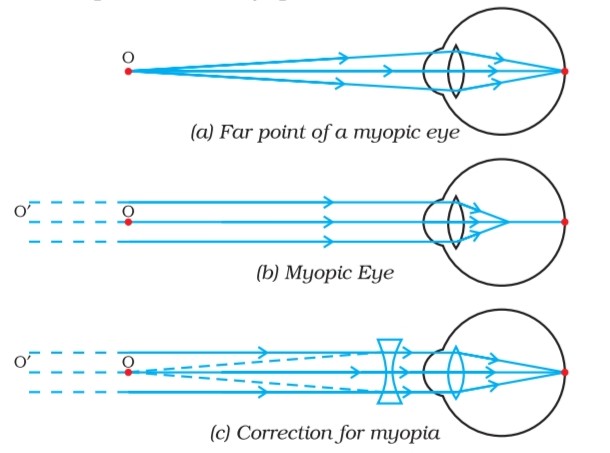
Q. Define hypermetropia. Write it’s causes. How is it Corrected?
Ans. A person suffering from hypermetropia can see far object but can not see nearby object clearly. This defect is also called farsightedness. In this defect near point increases from normal near point that is 25cm.
Causes:
- the focal length of the eye lens is too long, or
- the eyeball has become too small. This defect
Correction: As near point increases, the image of the object placed nearby formed behind the retina so not visible. So to form image on the retina rays need to be converged. A converging lens (convex lens) of suitable power can correct the defect of hypermetropia.
Diagrams related to hypermetropia:
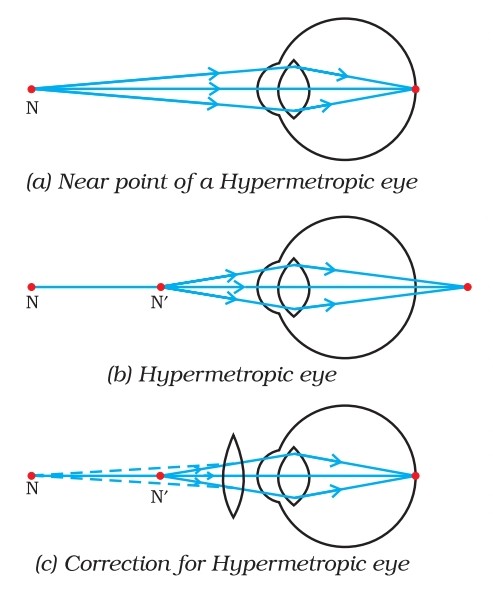
Q. Explain presbyopia.
Ans. In old age ciliary muscles become weak and loses it’s flexibility. In this way crystalline lens has no longer capability to adjust it’s focal length. That means there is lose of property of power of accommodation. So there will be difficulty to see both nearby (hypermetropia) and far (myopia) objects clearly.
A person suffering from presbyopia often require bi- focal lenses. A common type of bi-focal lenses consists of both concave and convex lenses. The upper portion consists of a concave lens. It facilitates distant vision. The lower part is a convex lens. It facilitates near vision.
……..Note…….
These days, it is possible to correct the refractive defects (myopia, hypermetropia and presbyopia) with contact lenses or through surgical interventions.
……………………Refraction & Reflection processes…….
Q. Define a. Dispersion b. Scattering c. Apparently position.
Ans. Dispersion: Dispersion of light is the process by which white light splits into its component colours. This happens when white light passes through a transparent medium, like a glass prism. Red colour have largest wavelength and violet have least. In a vacuum, red and violet light travel at the same speed. However, in a transparent medium, red light travels faster than violet light. So red light refracted or bent least while violet bent most.
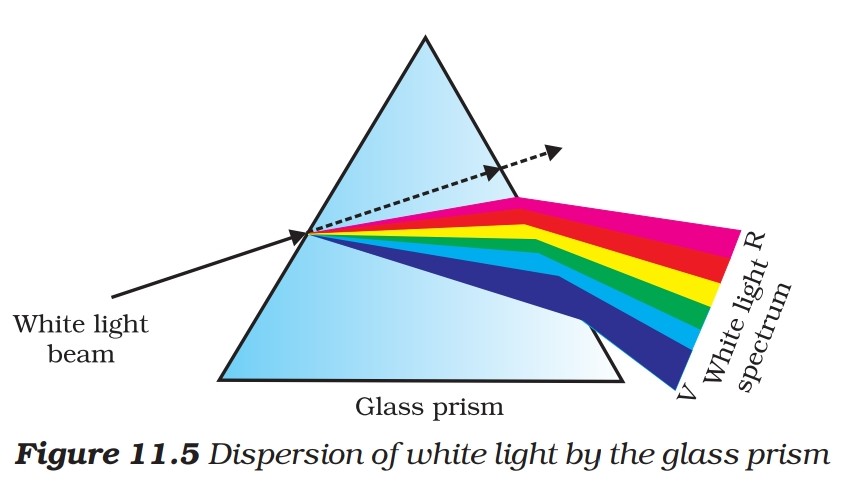
- The band of seven colours that is VIBGYOR formed by process of dispersion is called spectrum. Rainbow is an example of natural spectrum.
b. Scattering : the phenomenon that occurs when light rays change direction after hitting an atmospheric or colloidal particles. Scattering depends on the nature of the light and the surface it hits. Tyndall effect is due to scattering of light.
c. Apparent position: The actual position of star is slightly different than that it is actually seen by us. This is due to atmospheric refraction. Light undergoes continuous refraction by the atmosphere which changes it’s density and refractive index.
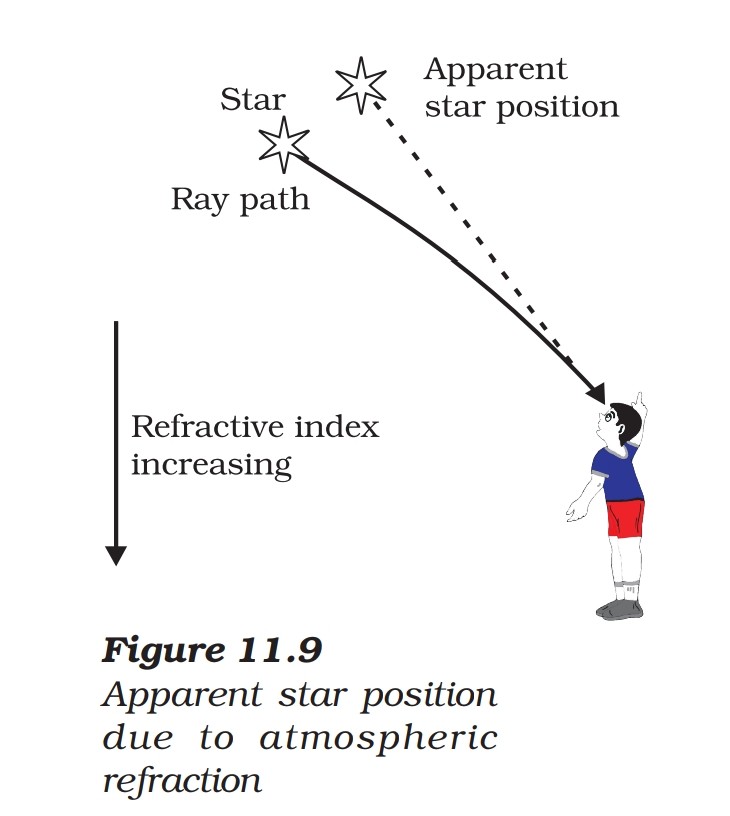
Q…..Reason behind blue colour of sky?
Ans. ……note…..The colour of the scattered light depends on the size of the scattering particles. Very fine particles scatter mainly blue light while particles of larger size scatter light of longer wavelengths. If the size of the scattering particles is large enough, then, the scattered light may even appear white.**** main answer is as follows….
Blue colour of sky is due to scattering of light from the blue end by the particles of atmosphere. The size of particles mainly determine which colour from light is to be scattered. Generally a pollution free atmosphere have particles size , which are capable to scatter light from blue end. The scattered blue colour reaches to our eyes and therefore sky appear blue.
Q. Draw diagram for refraction through triangular glass prism.
Ans.
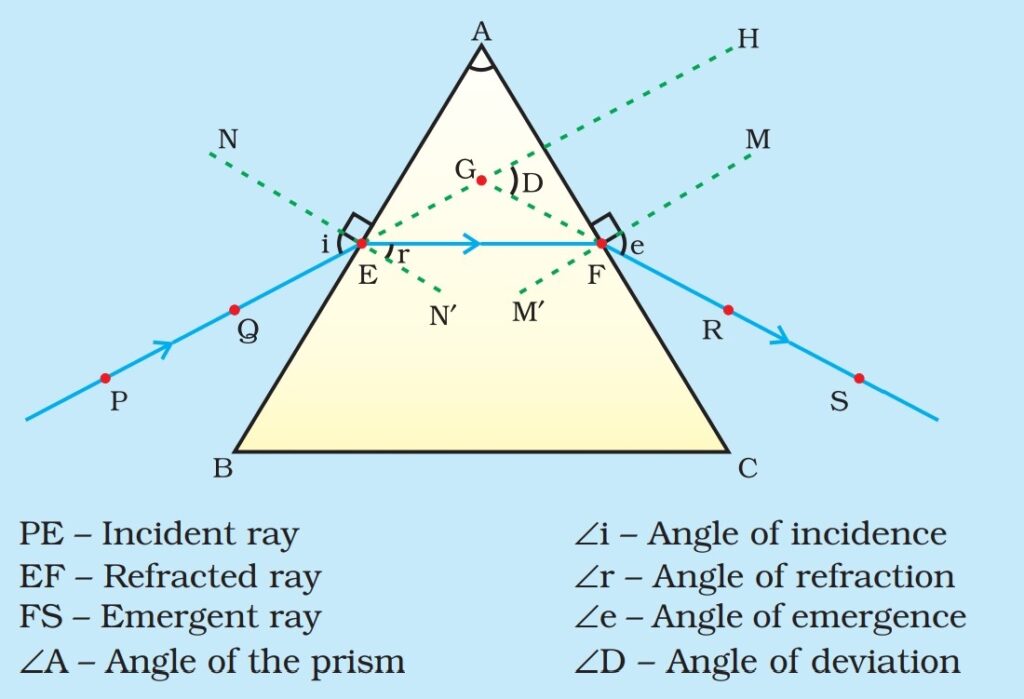
Q. Why do star twinkle?
Ans. Stars are very far from the earth so act as point source of light. Star light undergoes continuous refraction through atmosphere. As the path of rays of light coming from the star goes on varying slightly, the apparent position of the star fluctuates and the amount of starlight entering the eye flickers – the star sometimes appears brighter, and at some other time, fainter, which gives twinkling effect to star.
Q. Why planets do not twinkle?
Ans. The planets are much closer to the earth, and are thus seen as extended sources. If we consider a planet as
a collection of a large number of point-sized sources of light, the total variation in the amount of light entering our eye from all the individual point-sized sources will average out to zero, thereby nullifying the twinkling effect.
Q. What do you mean by recombination of white light?
Ans. White light splits into seven components colour while passing through prism, if we place a second prism in inverted position the seven colours recombine to give white light. By this experiment Newton conclude that white light constitute 7 colours.
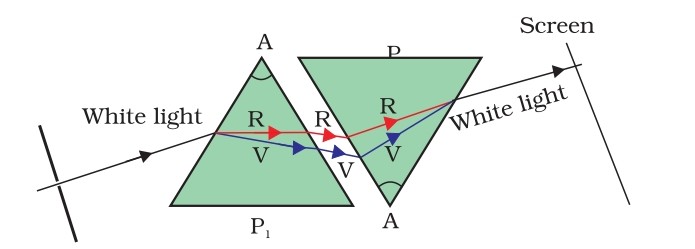
Q. Explain the formation of rainbow.
Ans. A rainbow is a natural spectrum appearing in the sky after a rain shower. It is caused by dispersion of sunlight by tiny water droplets, present in the atmosphere. A rainbow is always formed in a direction opposite to that of the Sun. The water droplets act like small prisms. They refract and disperse the incident sunlight, then reflect it internally, and finally refract it again when it comes out of the raindrop. Due to the dispersion of light and internal reflection, different colours reach
the observer’s eye.
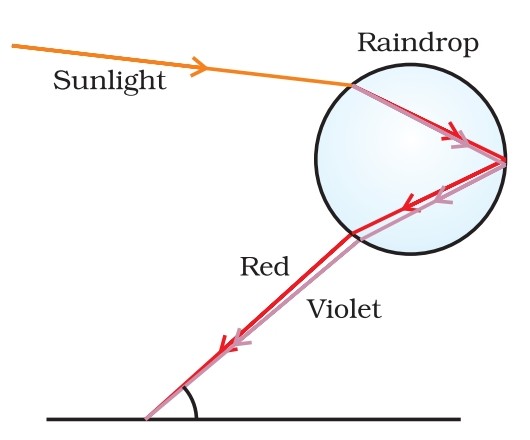
Q. What is the reason behind early sunrise and delayed sunset?
Ans. Sun appear 2minutes earlier sunrise and till 2minutes after the sunset, this is because apparent position of sun due to atmospheric refraction. By actual sunrise and sunset ,we mean actual crossing of horizon by the sun. The time difference between actual sunrise , sunset to their respective apparent position is 2minutes.
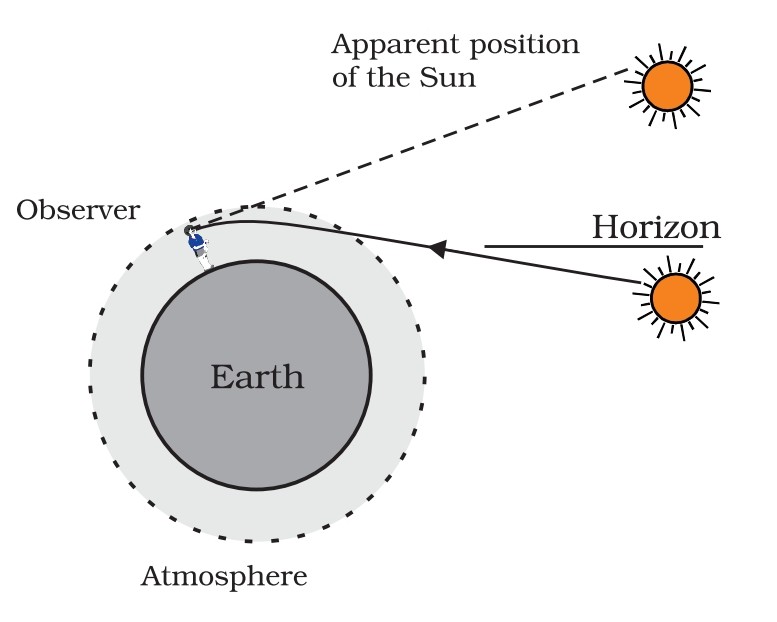
Q. What is reason behind reddish colour of sun during sunrise and sunset?
Ans. During sunrise and sunset, sun is at the horizon. So sunlight have cross thickest layer of atmosphere, shorter wavelength scattered away in the process. Only light of longer wavelengths reaches to our eyes. So sun appear reddish.
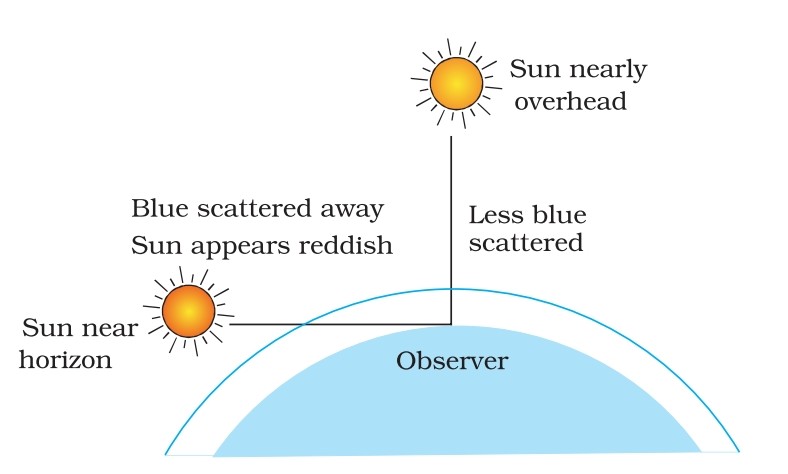
………..end of the page……..